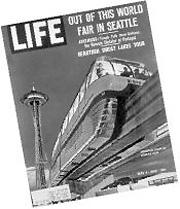WATCHING THE NEW Frank Gehry blob take shape at the foot of the Space Needle is exciting; it suggests there’s still a little “world’s fair” left in Seattle and the Center. I don’t know whether the Experience Music Project is going to be the best pavilion the Century 21 Exposition never had or the cybersuccessor to the deliciously kitschy old freak show/arcade, the Jones Museum, which used to occupy the Center House. In either case, the EMP will give the Center a boost it has needed for a long time—at least since they tore out the Bubbleator. It wouldn’t surprise me if Paul Allen and his sister Jody Patton feel some sort of nostalgia for the old fair and their new museum is, in a sense, a late contribution to it: populist, high-tech, ambitious, and weird.
I remember watching with great anticipation as the Seattle World’s Fair of 1962 took shape. I’ll sound like an old geezer when I say this, but I have a vivid memory of standing on the observation deck of the Smith Tower with an unobstructed view north to where the Space Needle was under construction. At that time, remarkably enough, the Smith Tower was still the tallest building in town. My fellow Cub Scouts and I got in a loud debate about which building was better: I was the only kid in the pack to take the Smith Tower’s side, probably because I was scared stiff by the thought of flying saucers which, after all, had been discovered and named near Mount Rainier. There’s a reason the Needle was Dr. Evil’s headquarters.
The fair promised to reveal the secrets of the next century, now this one. We were given the Monorail, and told that soon Seattleites and the world’s citizens would be whisked about on such devices; we were shown video telephones and told that we would be able to see the folks with whom we were talking, enjoying more face time with friends and distant relatives. And I distinctly remember examining a miniature model freeway with moving cars that demonstrated no signs of gridlock whatsoever: The superhighway was still the “road ahead.”
Nearly 40 years later, our 21st-century City Council is killing the monorail system the voters asked for and our regional rail system demonstrates the inadequacies of even our most ambitious efforts. The phone/TV convergence is finally happening, thanks to the personal computer (which I don’t remember seeing at the World’s Fair), but most of what we look at is nasty sex on the Internet where performers do what you tell ’em and guys like Seth Warshavsky get rich. And the superhighway has proved to be an asphalt noose around our neck.
THE SEATTLE WORLD’S fair was second rate, as world expositions go. Nothing like Brussels in ’58 or Montreal in ’67, or New York in 1939, the great futurist fair of the modern era, which featured the works of Picasso, Gershwin, Bel Geddes, and Frank Lloyd Wright, to name a few. That’s hard for me to say, because for a little kid growing up in Seattle, Century 21 was pretty magical. And it did give Seattle a new sense of itself as an international city, looking outward and forward. Best of all, unlike many fairs, it left a “legacy” behind in the shape of Seattle Center and its facilities. Few cities have so well utilized former fairgrounds. Robert Moses, for example, spent billions of tax dollars hosting two world’s fairs to try to make something out of the vast ash dumps in Queens. Today, Flushing Meadows is just a big, empty park, hardly the World of Tomorrow that was promised.
Seattle’s fair also came at a time when the whole notion of world’s fairs was being undercut by the very technologies they boosted: in a less isolated television and jet age, such gatherings of the world’s most exotic peoples, ideas, and technologies were becoming cumbersome expensive anachronisms. And globalization of the economy began to undercut the nationalism that so often added zeal (and cash) to corporate sponsorships that provided so much of the necessary funding. Plus, after Seattle, just about anybody thought they could host fairs: Even Spokane had one!
Interestingly, world’s fairs still happen, although you would never know it in this country. After big money-losers in cities such as New Orleans and Knoxville, expos found their niche overseas in Europe and Asia especially—places that are home to many emerging economies (China, Southeast Asia, Eastern Europe). One of the largest ever will be held this summer, a Universal Exposition in Hanover, Germany, featuring about 180 countries.
These fairs are still a chance for smaller countries to strut their stuff and hobnob with trade officials from other nations. Despite globalization and computers, a lot of business is still done face to face (and in backrooms); thus the need for actual meetings, like the Seattle WTO round or the excuse for Port and Chamber junkets.
More importantly, world’s fairs are a chance for countries to reinforce their “brand” identity. As international trade groups and corporate ownership erode national sovereignty, often what little a country has left is a cultural identity that might help promote tourism or provide an edge in making trade deals. Countries are companies and companies are countries: Norway, Swatch, Nike, Telemundo, Botswana, Virgin, Cisco.
So while folks in Seattle will be visiting a local billionaire’s multimedia event at our old fairgrounds, the rest of the world will be doing much the same thing, enjoying an event that is less a futurist extravaganza and more the New World Order’s Bumbershoot.
I’m going, and I’ll tell you all about it next month.







